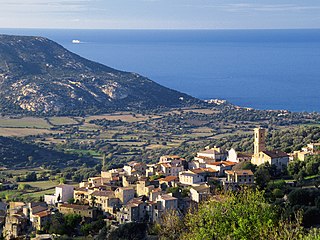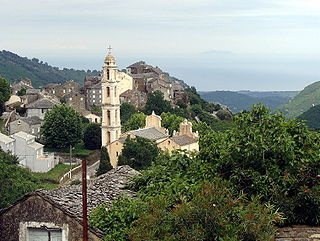
Bastia is a commune in the department of Haute-Corse, Corsica, France. It is located in the northeast of the island of Corsica at the base of Cap Corse. It also has the second-highest population of any commune on the island after Ajaccio and is the capital of the Bagnaja region and of the department.

Afa a commune in the Corse-du-Sud department on the island and collectivity of Corsica, France.

The arrondissement of Corte is an arrondissement of France in the Haute-Corse department in the territorial collectivity of Corsica. It has 158 communes. Its population is 60,236 (2021), and its area is 2,853.4 km2 (1,101.7 sq mi).

Aléria is a commune in the Haute-Corse department of France on the island of Corsica, former bishopric and present Latin Catholic titular see. It includes the easternmost point in Metropolitan France.

Asco is a commune in the Haute-Corse department of France on the island of Corsica.

Campi is a commune in the Haute-Corse department of France on the island of Corsica.

Aghione is a commune in the Haute-Corse department of France on the island of Corsica.

Albertacce is a commune in the department of Haute-Corse in the island and collectivity of Corsica, France.

Algajola is a commune in the Haute-Corse department of France on the island of Corsica.

Altiani is a commune in the Haute-Corse department of France on the island of Corsica.

Antisanti is a commune in the Haute-Corse department of France on the island of Corsica.

Aregno is a commune in the Haute-Corse department on the island of Corsica, France. The village was previously part of the piève of Aregnu in the former Genovese province of Balagna.

Barbaggio is a commune in the French department of Haute-Corse on the island of Corsica. It is known for its wine, its scenery, and the prehistoric site of Strette.
Canale-di-Verde or Canale di Verde is a commune in the French department of Haute-Corse, collectivity and island of Corsica.
Moïta is a commune in the Haute-Corse department, on the island of Corsica, France.

Pietra-di-Verde is a commune in the Haute-Corse department of France on the island of Corsica.

Zalana is a commune in the Haute-Corse department of France on the island of Corsica.
The Canton of Castagniccia is a canton of the Haute-Corse department, Corsica, France, named after the natural region of Castagniccia . It was created at the French canton reorganisation which came into effect in March 2015. Its seat is in San-Nicolao.
The canton of Ghisonaccia is an administrative division of the Haute-Corse department, southeastern France. It was created at the French canton reorganisation which came into effect in March 2015. Its seat is in Ghisonaccia.

The Bravone is a small coastal river in the department of Haute-Corse, Corsica, France.




















